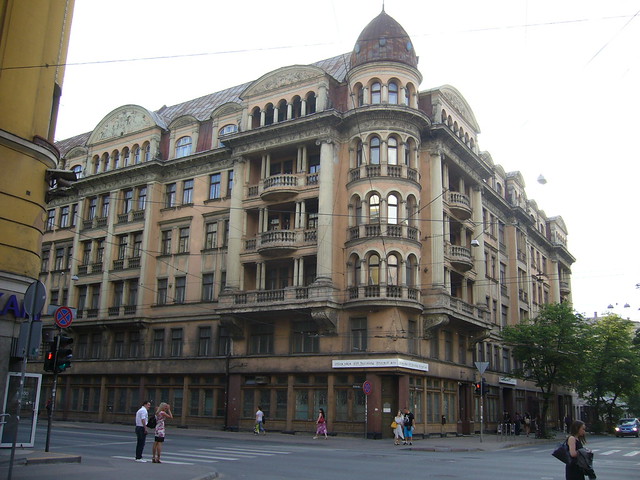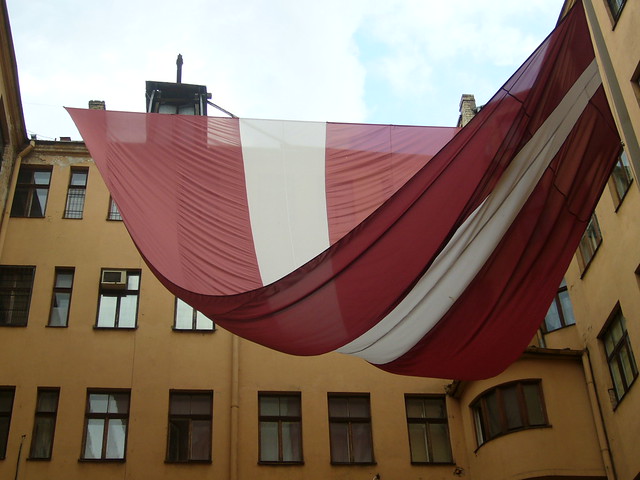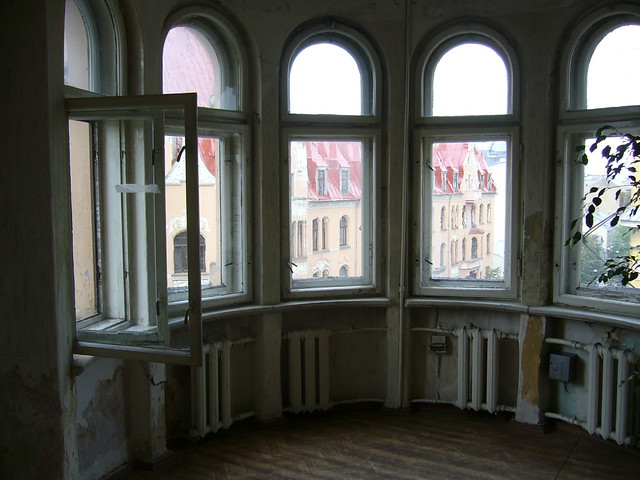Another instalment of our corner of a building series
Designed by Aleksandrs Vanags, the former KGB building in Riga, Latvia sports a corner worthy of a classy city department store. In fact, the Stúra mája building was designed as an apartment building with shops on the ground floor. Its neoclassicist rigidity, however, is punctuated by details quite in tune with the Art Nouveau buildings nearby.
The left face of the corner building, for instance, features two protruding bays, each crowned by a shallow gallery and a curved tympanum. But true to the contrary, teasing spirit of Art Nouveau, these two bays are totally different. The one nearest the corner is open, with a little balcony on each floor in front of a recessed terrace. The sides of the bay are marked with two fat Doric columns. The bay on the left, however, presents a stern, closed face with slender vertical accents. All in the Art Nouveau tradition of unpredictability.

When we drop our eyes to the ground floor, though, strict repetitive classicism is back. Once a series of shop windows, the rhythmic series of narrow windows hides a gruesome past. These were the Riga headquarters of the Cheka (Chrezvychaynaya Komissiya) and its successor, the KGB, when Latvia was part of the Soviet Union.
We were inside the building in July 2014. A chilling experience, particularly on the ground floor. Upstairs, long corridors lined with small offices housed several exhibitions. What objects do you grab when you have to leave immediately? Which objects, however insignificant, have been with you at all times? Stories of unimaginable suffering, and hope, emanated from simple suitcases, well-thumbed booklets and dusty cardigans.
But on the ground floor, you were unexpectedly led into a dark back room where Latvian suspects were tortured by KGB interrogators. The actual room. "You came in and they grabbed you from behind. You never saw them, they were hiding behind the door." The very door through which you had just come in as a 21st-century European tourist. This building, never mind its interesting exterior, deserves to be preserved as it is, if only for the sake of its ground floor and the whiff of KGB callousness around every other corner.
The inside court of this corner building, where an alleged Putin lookalike was crucified in 2015, may be architecturally unremarkable, but when we visited, a simple Latvian flag served as a reminder of the country's unabated striving towards permanent independence. This flag-waving was explained to us as not being the predictable nationalist move opposing the very sizable second-generation Russian minority in Latvia. They are part of the country through no fault of their own, nor of their parents. The flag simply symbolizes that Latvia belongs to nobody but those that live in the country, old and new Latvians alike.

Returning to the original topic, corners of buildings, the corner tower of Brïvïbas iela 61 in Rïga contained round office rooms on the second to the fifth floors. No doubt they were coveted by minor officials. If only they extracted enough information from suspected Latvian civilians, maybe they would get promoted to a room like that. The thought sends shivers through one's back; even the elaborate central heating system couldn't dispel the chill of history.

More about the building:
http://office.riga2014.org/wp-content/uploads/2014/10/avize_ENG_8.pdf
About the exhibitions inside the building:
http://riga2014.org/eng/news/40757-kgb-building
Visitors to the building, who enter through the inconspicuous corner entrance, just like summoned suspects did, are issued with an entrance pass based on the KGB one:
